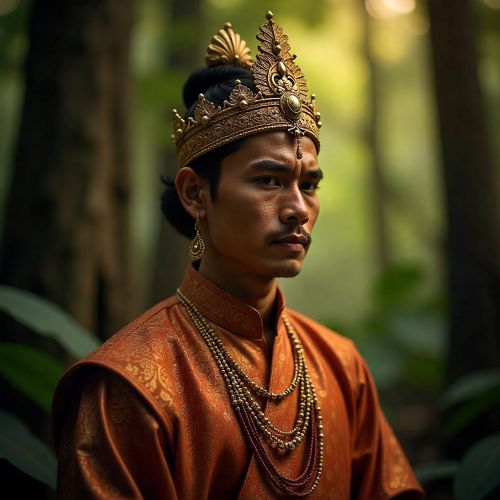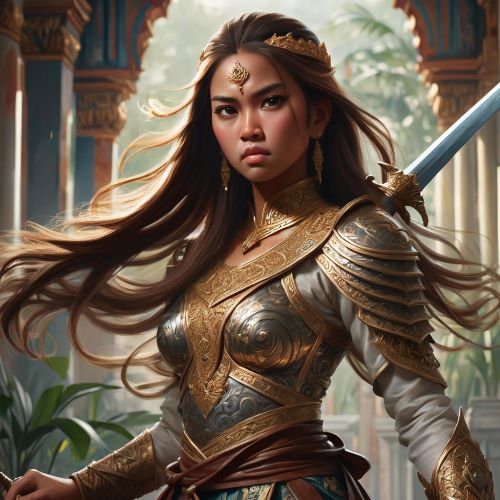Shanta : The Overlooked Princess of the Hikayat Seri Rama
Listen
At a glance
| Description | |
|---|---|
| Origin | Malaysian Mythology |
| Classification | Mortals |
| Family Members | Raja Dasarata (Father), Kausalya (Mother), Seri Rama, Baradan, Lakshmana, Shatrughna (Brothers) |
| Region | Malaysia |
| Associated With | Royalty |
Shanta
Introduction
Shanta is one of the most intriguing yet understated figures in the Hikayat Seri Rama, the Malay adaptation of the Ramayana that evolved between the 13th and 17th centuries. While she receives limited attention in many Indian retellings, the Malay version expands her narrative, giving her a dramatic presence that reshapes the early arc of the story. The Hikayat Seri Rama adapts the Indian epic through Malay cultural filters—blending local traditions, Islamic influences, and evolving storytelling forms—and Shanta becomes a character whose role symbolizes both royal vulnerability and spiritual significance. In this localized narrative, Shanta is not merely the daughter of King Dasaratha; she becomes a catalyst for key events that set the stage for later conflicts, especially through her abduction by Ravana, a plot element unique to the Malay tradition.
Physical Traits
While traditional Indian sources describe Shanta with emphasis on her beauty and composure, the Malay narrative approaches her appearance with symbolic nuance. Instead of focusing on detailed features, Hikayat Seri Rama frames Shanta through her aura—serenity, intelligence, and inner radiance. These qualities reflect her name, which derives from the Sanskrit word for “peace,” and underscore her function as a figure of harmony amid the tensions that permeate the story. In Malay storytelling, outward beauty is presented less visually and more spiritually; Shanta’s elegance and calmness are referenced in relation to her lineage and character, reinforcing her status as a royal daughter whose presence commands both admiration and respect.
Family
Shanta’s familial ties are central to her identity and influence. She is the eldest daughter of Raja Dasarata (Dasharatha) and Queen Kausalya, placing her as the older sister of Rama (Seri Rama), Bharata (Baradan), Lakshmana, and Shatrughna. The Malay adaptation gives her a specific narrative prominence through the crisis sparked by her abduction, a storyline absent in Valmiki’s Sanskrit Ramayana. In the Malay version, Ravana’s decision to seize Shanta marks an early assault on Dasarata’s lineage, foreshadowing his future abduction of Sita. This narrative choice reframes the royal family’s challenges, placing Shanta at the heart of political and cosmic disturbances.
While in some Indian traditions Shanta is adopted by King Romapada and later marries the ascetic Rishyasringa—whose ritual actions enable the births of Rama and his brothers—the Malay narrative reimagines her path entirely. Instead of ritual mediation, she becomes a symbol of dynastic threat and a reflection of the vulnerabilities faced by even the most revered kingdoms.
Other names
In Malay texts, Shanta appears under several localized titles that highlight her royal stature. She is sometimes referred to as Puteri Shanta, emphasizing her princesshood, or Shanta Dewi, underscoring her divine femininity within the cultural framework of Malay literature. These names maintain her connection to the Ramayana tradition while adjusting her presence to fit local storytelling aesthetics. The Malay versions often adapt names to suit their phonetic and cultural environment, as seen with Hanuman becoming Hanoman and Lanka becoming Langkapuri; yet Shanta’s name remains remarkably close to its Sanskrit original, reflecting her enduring association with peace and virtue.
Powers and Abilities
Shanta is not endowed with supernatural abilities in the traditional sense, but her influence is no less significant. In the Hikayat Seri Rama, her power derives from her wisdom, her capacity to affect emotional change, and her symbolic importance to the royal lineage. Her abduction by Ravana becomes a turning point not because she wields magical force, but because she represents the moral and political stability of Dasarata’s kingdom.
Early Malay sources also emphasize Shanta’s education in sacred texts, arts, and warfare—suggesting a multifaceted royal training that enhances her narrative depth. Her intelligence plays a role in tempering Ravana’s temperament in some versions, revealing her subtle ability to influence even the most formidable adversaries. Instead of outward magical feats, Shanta’s strength is encoded in her moral presence, emotional resilience, and the catalytic role she plays in shaping broader events within the epic.
Modern Day Influence
Shanta’s legacy endures through Malaysia’s rich cultural traditions that continue to reinterpret the Hikayat Seri Rama. She appears in wayang kulit Kelantan, where shadow puppetry keeps the epic alive through stylized performance and oral storytelling. Modern literary scholars highlight Shanta as a prime example of how Malay adaptations elevate characters who receive little attention in other versions of the Ramayana.
Her expanded role resonates with audiences exploring themes of agency, vulnerability, and female presence within epics traditionally centered on male heroes. In educational materials and children’s retellings, Shanta is increasingly recognized as a character who reflects the merging of Indic mythological foundations with Malay-Islamic cultural values.
Although the prominence of Hikayat Seri Rama has fluctuated—particularly after the Islamic revival of the 1980s—it remains a cornerstone of Malay literary history, and Shanta’s story persists as part of the broader conversation on Southeast Asian reinterpretations of global epics. Today, Shanta continues to symbolize quiet strength, familial devotion, and the complex interplay between cultural adaptation and mythological inheritance.
Related Images
Source
Narayana Murthy, U. (2022). Hikayat Seri Rama: Malaysian Ramayana. Literature Malaysia: Culture Series.
Sri Sathya Sai Speaks. (2002, May 19). Shanta – Rama’s Elder Sister. https://saispeaks.sathyasai.org/discourse/snippet/shanta-ramas-elder-sister
Education World. (2025, June 26). Malaysian Ramayana. https://educationworld.in/malaysian-ramayana/
Hikayat Seri Rama. (2006, October 7). Wikipedia. https://en.wikipedia.org/wiki/Hikayat_Seri_Rama
Boloji. (2025, October 23). Hikayat Seri Rama: A Review. https://www.boloji.com/articles/52575/hikayat-seri-rama-a-review
Writers Workshop India. (n.d.). Hikayat Seri Rama: The Malay Ramayana. https://www.writersworkshopindia.com/books/hikayat-seri-rama-the-malay-ramayana/
TheRajathr. (2015, December 21). Shanta the hidden character of Ramayana. https://therajathr.wordpress.com/2015/12/21/shanta-the-hidden-character-of-ramayana/
Frequently Asked Questions
Who is Shanta in the Hikayat Seri Rama?
Shanta is the eldest daughter of King Dasarata in the Malay adaptation of the Ramayana, playing a far more prominent role than in the Sanskrit version.
How is Shanta different in the Malay version compared to the Indian Ramayana?
In the Malay text, she is abducted by Ravana, a storyline not found in the original Sanskrit Ramayana.
What is Shanta known for in Malay literature?
She is known for her wisdom, serene nature, and narrative function as a catalyst for early conflicts in the epic.
Does Shanta have supernatural powers?
No, her influence comes from intelligence, moral strength, and the symbolic importance of her royal lineage.
How is Shanta remembered today?
She appears in wayang kulit, modern retellings, academic discussions, and as a symbol of cultural adaptation within Malaysia.









